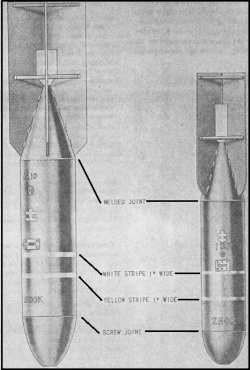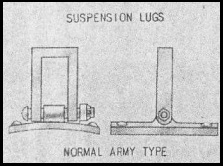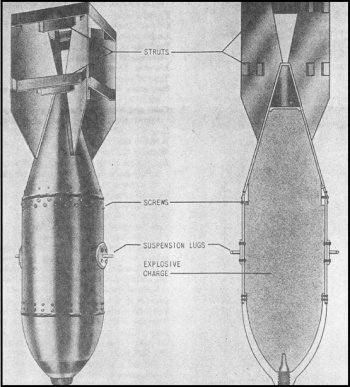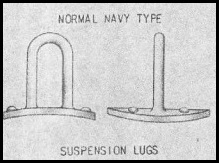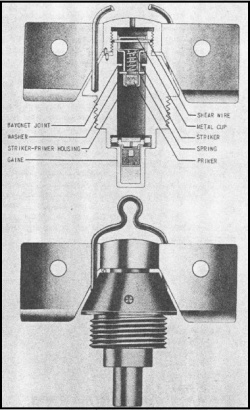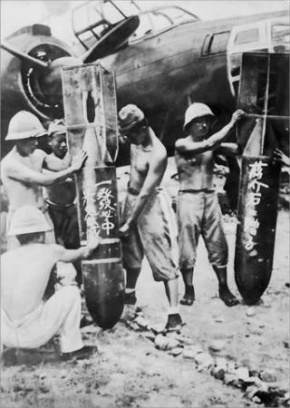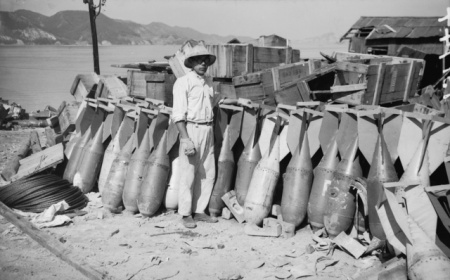Japan Bombs General Information
Japanese Bombs (Army and Navy)
Contents
General Information
The Japanese military separated the types of bombs used between the Japanese Army and Japanese Navy due to different requirements and missions performed between the two branches. Each service had its own type of construction, identification and designation for their bombs which were dissimilar between the services. While special adapters were made, most fuzes could not be used interchangeably between the services. The one exception to this was the usage of Navy bombs by the Japanese Army when they were conducting antisubmarine warfare.
Japanese Army
Bomb Specifics
- Type number
- The type number given on the bombs equates to the year in which the ordnance was accepted into service, not the year it was produced or in actual use. For example, if a bomb had been in production since 1936, usage started in 1938, and the ordnance was accepted into the service in 1939, the type number would be “Type 99” (more on the year number in the next paragraph). Up until the time of the reign of Emperor Showa (started in 1926), ordnance was designated by the era of the emperor in power. The year would correspond with the year of the Japanese Empire which would have been 2600 for 1940 (2599 for 1939, 2598 for 1938...etc…). So as noted in the previous paragraph, the “Type 99” correlates to the ordnance being adopted in the Japanese Empire year 2599 or in the currently used 1939. For the year 2600, it is possible it for it to be represented in one of two ways, either “Type 100” or “Type 0”. Single digit years past 2600 were typically represented by only the last digit, so 2602 would show up as “Type 2”. Ordnances authorized prior to the Showa era had a slightly different numbering convention; however, it is not relevant to gameplay in War Thunder and will not be mentioned here.
- Mark Number
- Typically this will be utilised with Navy bombs which were developed for a special purpose which differed enough from the original to warrant a “mark number” which would distinguish the two (or more) bombs from each other.
- Description of Ordnance
- Some ordnance may include one or two words as part of their identifier following the type number which gives a brief description of the specific ordnance.
- Model
- The general indication of the model number is to denote a change in the basic design of the original bomb.
- Modification
- Typically a modification number will represent a minor change in design or a change in the explosive filler utilised in the bomb.
Example: Type 1 250-kg High-Explosive Bomb is a bomb which was accepted in 1941, 250 kg and is high explosive.
Bomb Physical Characteristics
- Description
- The Japanese army typically uses short names for their bombs which get right to the point which includes a type number (year accepted), weight in kilograms and a descriptive title which is used on all bombs with the exception of general-purpose high-explosive bombs.
- Construction
- General-purpose bombs early on were constructed of three pieces where the tail cone which was filled with explosives was welded to a cylindrical body while the bomb nose was threaded on. However, in later models of Army bombs, the nose was welded, while the tail cone was threaded onto the bomb body.
- Suspension
- The Japanese Army selected a single hinged rectangular lug which was welded to the centre of gravity of the bomb as the point of connection to external pylon hard points or in the bomb bay of larger aircraft.
- Explosive Fillings
- Early Army general purpose high explosive bombs were typically filled with precast blocks of explosives wrapped in paper and sealed in paraffin, whereas later type bombs were precast in TNT. Bombs utilising an explosive filler other than picric acid would have the name of the filler stencilled on the bomb. If a filler other than the standard explosive filler was used, the Japanese character for “special” would also be stencilled on the bomb.
Bomb Specifics
Bombs for the Japanese Navy are divided into several classes; however, War Thunder is only interested in three: land bombs, ordinary bombs and special bombs. Bombs which are considered land bombs were designed specifically for land-based targets and had a rough texture on the exterior. Ordinary bombs, on the other hand, were designed specifically to be used against ships which included both general purpose and semi-armour piercing (SAP) types and were of a smoother construction when compared to land bombs. Special bombs were built for special circumstances where land or ordinary bomb would not complete the mission and were identified through being assigned a mark number:
- Mark 1 – 9 Anti-shipping bomb
- Mark 10 – 19 Chemical bomb
- Mark 20 – 29 Anti-aircraft bomb
- Mark 30 – 39 Anti-land bomb
Further designations are given to identify the bombs:
- Type number
- Indicates the year the bomb was adopted into service (see above for specifics on how the year is identified). In regards to the land and ordinary bombs, the first bomb of a specific weight class is not assigned a type number, but just a weight number. Subsequent bombs of the same weight class are assigned type numbers. For example, the first 50 kg bomb would have been listed as No. 5 (no matter what year it was accepted into service), and if a second bomb had been accepted in 1937, it would have been designated as Type 97 No. 5. If a third had been developed and accepted in 1941 then it would have been designated as Type 1 No. 5. Chronologically listing these bombs would appear in this order from oldest to newest:
- No. 5
- Type 97 No.5
- Type 1 No.5
- The number
- The number on the bomb specifies the weight of the bomb in tens of kilograms which correlates to the approximate weight of the bomb. A bomb with the designation No.5 would be a 50 kg bomb, whereas a bomb labelled No.80 would be an 800 kg bomb.
- The description
- The description of the bomb will be listed on the bomb with the associated character for land or ordinary usage, however special bombs will have a “Mark” number listed to denote its specific special category.
- Model
- This designation will distinguish between bombs of different designs within the same general class.
- Modification
- Modification will appear when there is a change to the explosive filling type.
Example: Type 99 No. 25 Ordinary Bomb Model 1 was accepted into service in 1939 as a 250 kg ordinary bomb, second model version of the 1939 250kg bomb.
Bomb Physical Characteristics
- Construction
- Navy bombs are typically constructed under two patterns, a land bomb version and an ordinary bomb (anti-shipping) version.
- Land bombs
- Typically, land bombs are assembled from three pieces, nose, cylinder body and tail cone section. The nose of the bomb can be attached through two methods, either welding and riveting or just welding alone. The tail cone is filled with explosive filler and is then to the body of the bomb with a collar or a coupling ring. The collar is attached to the body by welding and the coupling ring is attached to the tail, both sections are held together by screws through the coupling ring into the collar.
- Ordinary bombs
- Ordinary bombs, on the other hand, are made from two-piece construction. Here, instead of the nose and body being separate pieces, they are manufactured out of one block piece of metal and are machined both on the inside and out. In larger bombs where the tail cone is filled, this section will be threaded onto the bomb body and screws will secure the two sections together. In smaller bombs, the explosive typically will be in the bomb body and a base plate will be threaded into the body and will have a thread assembly in which the tail cone can attach.
- Suspension
- Bombs which are 250 kg or smaller will be suspended by a single U-shaped fixed lug. A second lug 180° apart can be fitted to allow the bomb to be suspended from a torpedo release gear.
- Explosive Fillings
- Unlike Army bombs, the bombs utilised by the Navy cast the explosive filler directly into the bomb case. Bomb casings are typically coated with a thick coat of lacquer prior to filling with explosive material.
Japanese Bombs In-Game
- Army Bombs
- Type 94 50 kg - 50 kg GPHE bomb accepted into service in 1934
- Type 94 100 kg - 100 kg GPHE bomb accepted into service in 1934
- Type 92 250 kg - 250 kg GPHE bomb accepted into service in 1932
- Type 92 500 kg - 500 kg GPHE bomb accepted into service in 1932
- Navy Bombs
- Type 97 №.6 - 60 kg ordinary bomb accepted into service in 1937
- №.25 Model 2 - 250 kg ordinary bomb, accepted into service prior to 1938
- Type 98 №.25 - 250 kg ordinary bomb, accepted into service in 1938
- №.50 Model 2 - 500 kg ordinary bomb, accepted into service prior to 1942
- Type 2 №.50 Model 1 - 500 kg semi armor piercing bomb, accepted into service in 1942
- №.80 Model 1 - 800 kg ordinary bomb, accepted into service prior to 1939
- Type 99 №.80 Mk 5 - 800 kg armor-piercing bomb, accepted into service in 1939
- Foreign Bombs
- 750 lb JM117 cone 45 - This is the Japanese version of the U.S. bomb 750 lb M117 cone 45.


